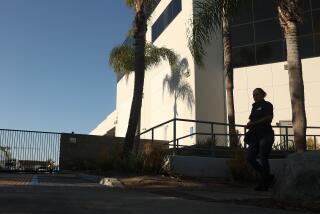Heat Sending Border Patrol to the Rescue
HOUSTON — Border Patrol agents, who normally block illegal immigrants from entering the U.S., lately have become their rescuers, searching out and reviving scores battered by the unrelenting heat wave in the Southwest. The number of illegal immigrants dead in Texas from heat-related causes reached 43 on Monday.
The toll is sure to rise. “Every summer, we’re on alert,” said Border Patrol spokeswoman Paty Mancha. “But it’s different this year because it’s so much hotter, there’s a drought, and people are dehydrated and dying.”
Agents up and down the Texas-Mexico border are pitching in, stocking patrol vehicles with medical supplies and five-gallon water jugs, then driving into the brush to search for stranded illegal immigrants. And they’ve taken helicopters to search for the travelers in remote areas unreachable by truck. “They’re spending as much time searching for victims as they are doing their regular job,” Mancha said.
Border Patrol crackdowns in the lower Rio Grande Valley, El Paso and Southern California are partly to blame for the increasing death toll this summer, officials acknowledge. With familiar routes blocked, illegal immigrants are forced to take untried paths through sparsely populated areas.
“Everyone is being funneled through Del Rio, and there’s little here to sustain human life under these hot conditions,” said another Border Patrol spokesman, Carlton Jones.
Death is always present along the border, but rarely at such levels. Last year, for instance, officials said they counted nine bodies in the 56,000-square-mile Del Rio sector, which runs from the Big Bend National Park to Laredo in South Texas; this year, since May alone, there have been 17 deaths reported.
Public service announcements produced by the Border Patrol air annually in Mexico. “It’s better to be alive and poor than dead and rich,” warns an official in Spanish. Border crossers detained in Texas are shown a gruesome film of dead bodies and rattlesnakes to drive home the point that the trek across the state can be deadly.
“We do this every year,” Mancha said. “This year, it’s more intense because the problem is bigger.”
It seems to be having minimal effect.
“You can put up all the warnings you want, but if they don’t have money, they’re going to come over, they’ll take the risk,” said Gavino Hernandez, chief deputy in the Kenedy County sheriff’s department.
At Piedras Negras, across the border from Eagle Pass, dozens of men sleep at the bus depot or river bank, waiting for nightfall before wading across the Rio Grande. Often they travel with little more than a plastic gallon jug of water or a compass to direct them north.
The terrain is numbingly similar: miles and miles of underbrush and dirt; a flat, desolate landscape. It’s easy to become lost and disoriented, which is what happened to Luis Javier Mejia-Pinon, 20, who crossed Saturday from Piedras Negras with a friend, walking north through the night and the next day.
Unaccustomed to the brutal heat and badly dehydrated, Mejia-Pinon began hallucinating, Mancha said. As he crawled under a bush to hide, his friend went for help. When the Border Patrol found Mejia-Pinon at 5:45 p.m. Sunday, he was dead.
The same weekend, 35-year-old Alberto Martinez Lozano crossed the border into Webb County. When the heat caused Lozano to collapse, his friends ran to find help at a nearby ranch. A ranch hand called authorities, but Lozano was already dead.
The Mexican consulate in Eagle Pass arranged for both of the bodies to be returned to Mexico. Most of the dead illegal immigrants found in Texas do not carry identification, and are buried in a pauper’s grave in the county where they die.
“They can be out in the sun for weeks, and they’re very hard to identify,” said Rafael Cuellar Jr., sheriff of Kenedy County, where 10 dead illegal immigrants have been found this summer. “You ask people why they are risking their lives in this heat. Aren’t they afraid of dying? They say, ‘No, we just want jobs.’ ”
Many of the dead that Cuellar has found are young men who apparently think they can beat the heat. “The older people have more experience, they go in the shade and don’t walk so fast. The young ones being strong, they just keep going until it’s too late. You can see it in their eyes. Water isn’t going to help them anymore.”
If relatives cannot be located, burial is at county expense. “Two to three thousand a body, and the county pays for it,” said the sheriff with a sigh. “I hope the federal government will think about paying us back.”
There have been deaths elsewhere along the border, officials said, but because weather conditions have not been as extreme for as long, the toll elsewhere hasn’t been as severe.
The Texas heat shows no sign of abating. Temperatures soared above 100 degrees for the 15th straight day in Dallas, and health officials said two more elderly residents had died from the heat. Their deaths took the number of heat-related victims to 22 for Dallas County, 81 for the state.
Border town temperatures were similarly brutal. McAllen, in the lower Rio Grande Valley, posted a high mark of 102; Del Rio was at 104; and Laredo, in West Texas, hit 107. Weather forecasters predict two more weeks of triple-digit temperatures in some parts of the state.
More to Read
Sign up for Essential California
The most important California stories and recommendations in your inbox every morning.
You may occasionally receive promotional content from the Los Angeles Times.









